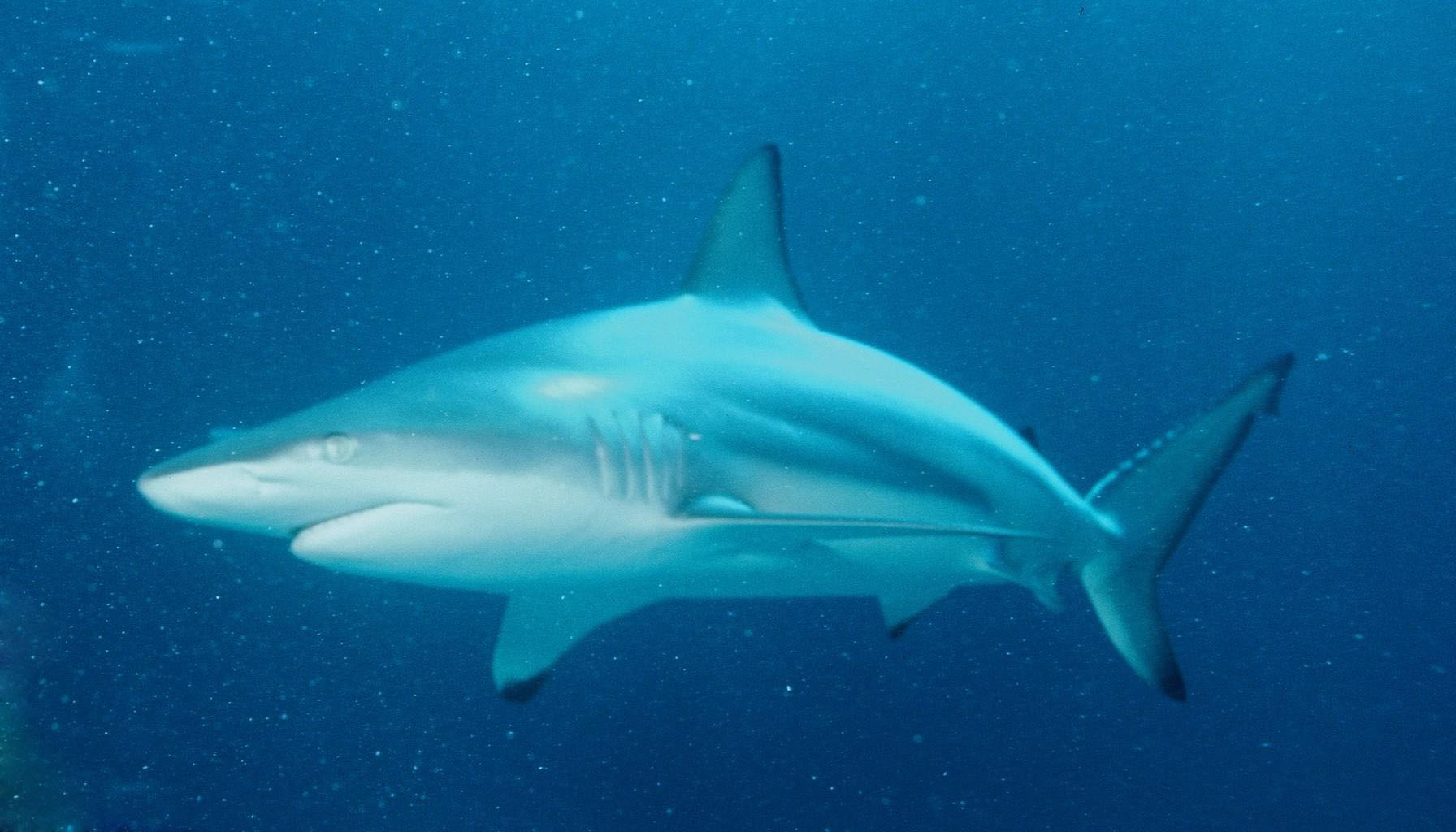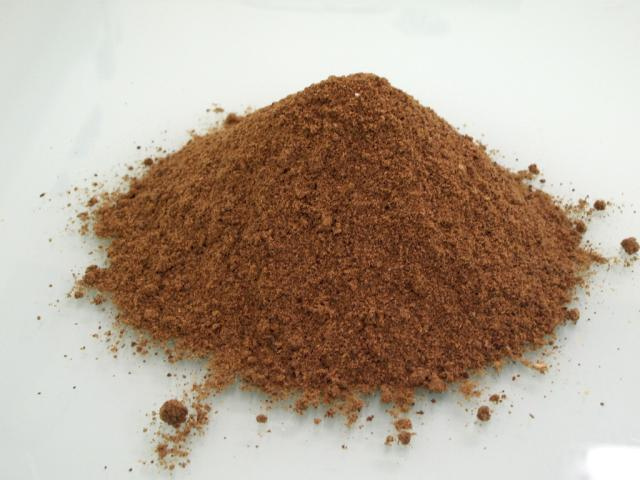|
Carcharhinus Sorrah
The spot-tail shark, or sorrah shark (''Carcharhinus sorrah''), is a species of requiem shark, in the family Carcharhinidae, found in the tropical Indo-West Pacific Ocean between latitudes 31°N and 31°S, from the surface to a depth around . This shark grows to about . It is fished commercially over much of its range and the IUCN considers it to be near threatened. Description The spot-tail shark is a spindle-shaped fish growing to about . It has a fairly long, pointed snout and moderately large eyes. The first dorsal fin is large and curved, while the second dorsal fin is small and low. The back and sides are grey and the belly white, and a long white streak is on the flank. This species can be distinguished from other requiem sharks found in tropical waters by the distinctive black tips to the second dorsal fin, the pectoral fins, and the lower lobe of the caudal fin. A ridge over the spine extends from the first to the second dorsal fin and a pit just in front of the upper ... [...More Info...] [...Related Items...] OR: [Wikipedia] [Google] [Baidu] |
Carcharhinus
''Carcharhinus'' is the type genus of the family Carcharhinidae, the requiem sharks. One of 12 genera in its family, it contains over half of the species therein. It contains 35 extant and eight extinct species to date, with likely more species yet to be described. Species Extant T Type species Fossil See also * List of prehistoric cartilaginous fish genera This list of prehistoric cartilaginous fish genera is an attempt to create a comprehensive listing of all genera that have ever been included in the class chondrichthyes ''and'' are known from the fossil record. This list excludes purely vernacul ... References Bibliography * * * * * * * {{Taxonbar, from=Q312359 Shark genera Extant Eocene first appearances Taxa named by Henri Marie Ducrotay de Blainville ... [...More Info...] [...Related Items...] OR: [Wikipedia] [Google] [Baidu] |
Australian Blacktip Shark
The Australian blacktip shark (''Carcharhinus tilstoni'') is a species of requiem shark, in the family Carcharhinidae, endemic to northern and eastern Australia. Favoring the upper and middle parts of the water column, it can be found from the intertidal zone to a depth of . Appearance-wise this species is virtually identical to the common blacktip shark (''C. limbatus''), from which it can be reliably distinguished only by its lower vertebra number and by genetic markers. Generally reaching in length, it is a fairly stout-bodied, bronze-colored shark with a long snout and black-tipped fins. Primarily piscivorous, the Australian blacktip shark forms large groups of similar size and sex that tend to remain within a local area. It exhibits viviparity, meaning that the unborn young are provisioned through a placental connection. There is a well-defined annual reproductive cycle with mating occurring in February and March. Females bear one to six pups around January of the followi ... [...More Info...] [...Related Items...] OR: [Wikipedia] [Google] [Baidu] |
Fish Meal
Fish meal is a commercial product made from whole wild-caught fish, bycatch and fish by-products to feed farm animals, e.g., pigs, poultry, and farmed fish.R. D. Miles and F. A. Chapman.FA122: The Benefits of Fish Meal in Aquaculture DietsFisheries and Aquatic Sciences Department, UF/IFAS Extension. Original publication date November 2005. Reviewed January 2015. Because it is calorically dense and cheap to produce, fishmeal has played a critical role in the growth of factory farms and the number of farm animals it is possible to breed and feed. Fishmeal takes the form of powder or cake. This form is obtained by drying the fish or fish trimmings, and then grinding it. If the fish used is a fatty fish it is first pressed to extract most of the fish oil.M. L. Windsor for the UK Department of Trade and Industry, Torry Research StationFish meal. Torry Advisory Note No. 49Published by FAO in partnership with Support unit for International Fisheries and Aquatic Research, SIFAR, 2001) B ... [...More Info...] [...Related Items...] OR: [Wikipedia] [Google] [Baidu] |
Shark Fin Soup
Shark fin soup is a traditional soup or stewed dish served in parts of China, Taiwan, and Southeast Asia. The shark fins provide texture, while the taste comes from the other soup ingredients. It is commonly served at special occasions such as weddings and banquets, or as a luxury item.Keith BradsherDisneyland in China Offers a Soup and Lands in a Stew 17 June 2005 ''The New York Times'' However, it has been condemned by the Humane Society International, which states that approximately 72 million sharks are killed each year for their fins. Currently, international concerns over the sustainability and welfare of sharks have impacted consumption and availability of the soup worldwide. Recently, health concerns about the high concentration of BMAA in shark fins have arisen. Shark fin soup substitutes have lately appeared on the market which do not require any shark fins, thus avoiding the environmental damage caused by the shark finning practice. Preparation Traditional shark ... [...More Info...] [...Related Items...] OR: [Wikipedia] [Google] [Baidu] |
Bass (fish)
Bass () is a name shared by many species of fish. The term encompasses both freshwater and marine species, all belonging to the large order Perciformes, or perch-like fishes. The word ''bass'' comes from Middle English , meaning 'perch'. Types * The black basses, such as the Choctaw bass (''Micropterus haiaka''), Guadalupe bass (''M. treculii''), largemouth bass (''M. salmoides''), smallmouth bass (''M. dolomieu''), and spotted bass (''M. punctulatus''), belong to the sunfish family Centrarchidae. * The temperate basses, such as the European seabass (''Dicentrarchus labrax''), striped bass (''Morone saxatilis'') and white bass (''M. chrysops''), belong to the family Moronidae. * The Asian seabasses, such as the Japanese seabass (''Lateolabrax japonicus'') and Blackfin seabass (''L. latus''), belong to the family Lateolabracidae. Other species known as bass Many species are also known as basses, including: * The Australian bass, ''Macquaria novemaculeata'', is a member of ... [...More Info...] [...Related Items...] OR: [Wikipedia] [Google] [Baidu] |
Bonito
Bonitos are a tribe of medium-sized, ray-finned predatory fish in the family Scombridae – a family it shares with the mackerel, tuna, and Spanish mackerel tribes, and also the butterfly kingfish. Also called the tribe Sardini, it consists of eight species across four genera; three of those four genera are monotypic, having a single species each. Bonitos closely resemble the skipjack tuna, which is often called a bonito, especially in Japanese contexts. Etymology The fish's name comes from the Spanish ''bonito'' 'pretty'.''Oxford English Dictionary'', 3rd edition, 2018''s.v.''/ref> An older theory suggests that it comes from an Arabic word ''bainīth'', but that may have been derived from Spanish as well. Species * Genus '' Sarda'' ( Cuvier, 1832) ** Australian bonito, ''S. australis'' (Macleay, 1881) ** '' Sarda chiliensis'' (Cuvier, 1832) *** Eastern Pacific bonito, ''S. c. chiliensis'' (Cuvier, 1832) *** Pacific bonito, ''S. c. lineolata'' ( Girard, 1858) ** Striped b ... [...More Info...] [...Related Items...] OR: [Wikipedia] [Google] [Baidu] |
Predation
Predation is a biological interaction where one organism, the predator, kills and eats another organism, its prey. It is one of a family of common feeding behaviours that includes parasitism and micropredation (which usually do not kill the host) and parasitoidism (which always does, eventually). It is distinct from scavenging on dead prey, though many predators also scavenge; it overlaps with herbivory, as seed predators and destructive frugivores are predators. Predators may actively search for or pursue prey or wait for it, often concealed. When prey is detected, the predator assesses whether to attack it. This may involve ambush or pursuit predation, sometimes after stalking the prey. If the attack is successful, the predator kills the prey, removes any inedible parts like the shell or spines, and eats it. Predators are adapted and often highly specialized for hunting, with acute senses such as vision, hearing, or smell. Many predatory animals, both vertebrate and inv ... [...More Info...] [...Related Items...] OR: [Wikipedia] [Google] [Baidu] |
Continental Shelf
A continental shelf is a portion of a continent that is submerged under an area of relatively shallow water, known as a shelf sea. Much of these shelves were exposed by drops in sea level during glacial periods. The shelf surrounding an island is known as an ''insular shelf''. The continental margin, between the continental shelf and the abyssal plain, comprises a steep continental slope, surrounded by the flatter continental rise, in which sediment from the continent above cascades down the slope and accumulates as a pile of sediment at the base of the slope. Extending as far as 500 km (310 mi) from the slope, it consists of thick sediments deposited by turbidity currents from the shelf and slope. The continental rise's gradient is intermediate between the gradients of the slope and the shelf. Under the United Nations Convention on the Law of the Sea, the name continental shelf was given a legal definition as the stretch of the seabed adjacent to the shores of a par ... [...More Info...] [...Related Items...] OR: [Wikipedia] [Google] [Baidu] |
Johannes Peter Müller
Johannes Peter Müller (14 July 1801 – 28 April 1858) was a German physiologist, comparative anatomy, comparative anatomist, ichthyology, ichthyologist, and herpetology, herpetologist, known not only for his discoveries but also for his ability to synthesize knowledge. The paramesonephric duct (Müllerian duct) was named in his honor. Life Early years and education Müller was born in Koblenz, Coblenz. He was the son of a poor shoemaker, and was about to be apprenticed to a saddler when his talents attracted the attention of his teacher, and he prepared himself to become a Roman Catholic Priest. During his Secondary school, college course in Koblenz, he devoted himself to the classics and made his own translations of Aristotle. At first, his intention was to become a priest. When he was eighteen, his love for natural science became dominant, and he turned to medicine, entering the University of Bonn in 1819. There he received his Doctor of Medicine, M.D. in 1822. He then studie ... [...More Info...] [...Related Items...] OR: [Wikipedia] [Google] [Baidu] |
Friedrich Gustav Jakob Henle
Friedrich Gustav Jakob Henle (; 9 July 1809 – 13 May 1885) was a German physician, pathologist, and anatomist. He is credited with the discovery of the loop of Henle in the kidney. His essay, "On Miasma and Contagia," was an early argument for the germ theory of disease. He was an important figure in the development of modern medicine. Biography Henle was born in Fürth, Bavaria, to Simon and Rachel Diesbach Henle (Hähnlein). He was Jewish. After studying medicine at Heidelberg and at Bonn, where he took his doctor's degree in 1832, he became prosector in anatomy to Johannes Müller at Berlin. During the six years he spent in that position he published a large amount of work, including three anatomical monographs on new species of animals and papers on the structure of the lymphatic system, the distribution of epithelium in the human body, the structure and development of the hair, and the formation of mucus and pus. In 1840, he accepted the chair of anatomy at Zürich an ... [...More Info...] [...Related Items...] OR: [Wikipedia] [Google] [Baidu] |
IUCN
The International Union for Conservation of Nature (IUCN; officially International Union for Conservation of Nature and Natural Resources) is an international organization working in the field of nature conservation and sustainable use of natural resources. It is involved in data gathering and analysis, research, field projects, advocacy, and education. IUCN's mission is to "influence, encourage and assist societies throughout the world to conserve nature and to ensure that any use of natural resources is equitable and ecologically sustainable". Over the past decades, IUCN has widened its focus beyond conservation ecology and now incorporates issues related to sustainable development in its projects. IUCN does not itself aim to mobilize the public in support of nature conservation. It tries to influence the actions of governments, business and other stakeholders by providing information and advice and through building partnerships. The organization is best known to the wider ... [...More Info...] [...Related Items...] OR: [Wikipedia] [Google] [Baidu] |
31st Parallel South
The 31st parallel south is a circle of latitude that is 31 degrees south of the Earth's equatorial plane. It crosses the Atlantic Ocean, Africa, the Indian Ocean, Australasia, the Pacific Ocean and South America. At this latitude the sun is visible for 14 hours, 13 minutes during the December solstice and 10 hours, 04 minutes during the June solstice. Around the world Starting at the Prime Meridian and heading eastwards, the parallel 31° south passes through: : See also *30th parallel south The 30th parallel south is a circle of latitude that is 30 degrees south of the Earth's equator. It stands one-third of the way between the equator and the South Pole and crosses Africa, the Indian Ocean, Australia, the Pacific Ocean, South Am ... * 32nd parallel south {{geographical coordinates, state=collapsed s31 ... [...More Info...] [...Related Items...] OR: [Wikipedia] [Google] [Baidu] |




_with_its_prey.jpg)


